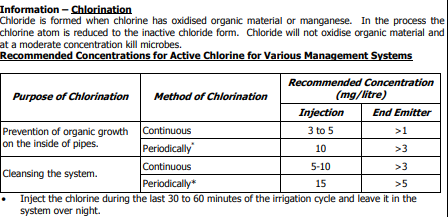Water Quality and Processing Systems
Most micro irrigation systems include one or more processing systems to improve the quality of irrigation water. For the irrigation of citrus by means of micro-jets and drippers filtration, acidification and disinfection are standard procedures. The frequency of acidification and disinfection depends on the quality of the irrigation water.
Filtration
Designing an irrigation system usually includes a filtration system. The type and number of filters depending on the quality of the irrigation water and the type of irrigation system. Little or no filtration is required for flood irrigation, while a dripper system will almost always use some sort of filtration.
The filtrations system may include one or more of the following:
- Sedimentation dams
- Cyclones
- Sand filters
- Mesh filters
- Disc filters
The operation and maintenance procedures are prescribed by the supplier or manufacturer of the system, and will not be discussed in this section. However, these procedures should form part of the system’s management protocols.
Acidification
Acidification is done by using techniques that vary in their degree of sophistication. The techniques include pre-dilution of the acid before adding it to the irrigation water; adding the concentrated acid to the water during irrigation by means of pumps or suction action. Pumps and suction units used for this purpose are controlled manually or by computer.
Whatever technique is used, the operation and maintenance instructions will be supplied by the supplier or manufacturer. These procedures should form part of the system’s management protocols.
Acidification is also done to dissolve carbonates of calcium and magnesium which pose a clogging hazard by continuous application of acids, such as in hydroponics, or by using a so-called shock treatment. The shock treatment allows the acid at a concentration of 0.6% (Leading drip irrigation supplier, 1998) to remain in the system for one hour, after which it is flushed out with irrigation water. The 0.6% concentration is applicable only when the concentration of the various acids is:
- Hydrochloric acid 33-35%;
- Sulphuric acid 70%;
- Nitric acid 60%; and
- Phosphoric acid 85%
If the concentration of the available acids differs from these values, adapt the % with a factor of 0.6 x % stated / % available.

Nitric acid is the most preferred chemical for this purpose because all nitrates are soluble in water and nitrate is also an essential nutrient.
The following procedures are recommended (Leading drip irrigation supplier, 2000):
- Calculate the volume of water in the system at operating pressure.
- Calculate the volume acid required to add 0.6% acid to the volume of water in the system.
- Connect the injector pump to the irrigation system to be cleaned after the filter.
- Start the irrigation system and let it gain operating pressure.
- Inject the acid into the system over a period of at least 10 minutes.
- Stop the irrigation to the specific block for one hour.
- Resume irrigation for at least another hour to flush out the acid and regain the pH in the soil/root zone before the acidification process.
Disinfection
Disinfection of the water and system is done by applying sodium or calcium hypochlorite, hydrogen peroxide, ozone or other disinfectants. Hypochlorite and hydrogen peroxide is the most commonly applied agents. The principle of disinfection is that the chemicals kill the microbes, oxidize some of the simple organic molecules and even manganese and iron. These chemicals can be used in maintenance or corrective program.
Maintenance Application: In the maintenance program, these chemicals are applied at frequencies determined by historical data and current assessments and/or analyses. The microbial counts in the irrigation water initiate the inclusion in the maintenance program. Data on clogged drippers or micro-jets and analyses of the deposits in the pipes determine the frequency.
Corrective Application: Corrective or shock treatments are done to bring the microbial population down to acceptable levels in a short period. This is done by applying the chemical at a high concentration at the end of the irrigation cycle.
Chlorination
Chlorine is a strong oxidising agent. It oxidises organic deposits and slimes to carbon dioxide. In this process, the living organisms are killed. Iron and manganese will also be oxidised to prevent precipitation. Microbes, iron and manganese must be in contact with the chlorine for a minimum period and at a minimum concentration in order for the oxidation to be completed.

The following procedures are recommended:
- Apply the chlorine as closely as possible to the system to be cleaned;
- The pH of the water should be between 6.5 and 7.2;
- When chlorination is done to precipitate iron and manganese, apply the chlorine before the filters.
- Before chlorination, flush the laterals properly.
- Free chlorine must be present at a concentration between 1mg and 5mg per litre at the emitter furthest from the injection, otherwise, chlorination is incomplete.
- Chlorine concentrations exceeding 100mg per litre may damage certain parts of the system.
- Never mix chlorine and acid; x Use protective clothing and safety gear when handling acids and chlorine.